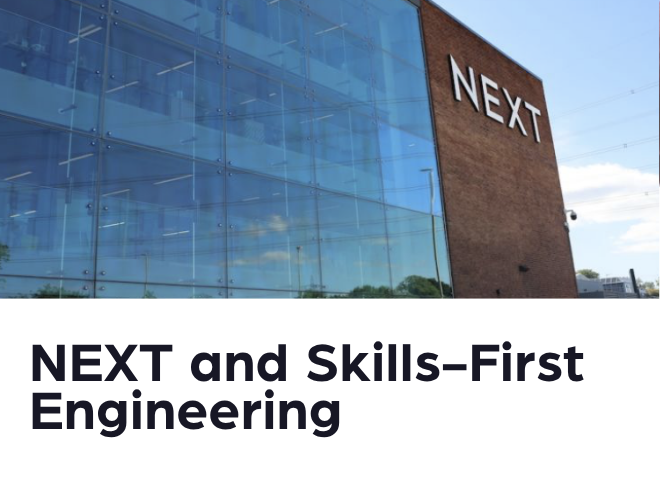We hosted a Career Recon session to dig into the data centre industry. If you missed it, you missed an eye-opener on one of the fastest-growing parts of the global economy, and one that’s desperate for the kind of talent veterans bring.
Ben sat down with Dan Cole, Director of Talent Acquisition EMEA at Digital Realty, and David Ashley, IBX Data Centre Manager at Equinix. What came out was clear: data centres aren’t just about racks and servers. They’re the hidden backbone of everyday life, from your banking app to NHS systems to the AI tools reshaping work. And the industry is expanding faster than the workforce can keep up.
Here’s what we learned:
The Scale of the Build-Out
Global data centre capacity is doubling by 2030. London alone has seen a staggering 58% year-on-year jump. Why? Cloud demand, non-stop streaming, and AI workloads that burn through power at an unprecedented rate.
It’s not just a UK story. In the US, the build-out is even more aggressive. Northern Virginia - often called “Data Centre Alley” - has more capacity than the next five global markets combined. Dallas, Chicago, and Phoenix aren’t far behind, and hyperscalers like Amazon, Microsoft, and Google are locking in long-term leases before the concrete is even poured.
Operators everywhere are racing to secure land, power, and cooling. But here’s the pinch point: the workforce isn’t keeping up. You can pour billions into new facilities, but without skilled people to design, operate, and maintain them, they’re just expensive sheds.
The problem? While operators are pouring money into new builds, the talent pipeline hasn’t caught up. There simply aren’t enough people who can design, operate, and maintain facilities at this scale.
What’s Really Inside a Data Centre
Forget the cliché of a dark server room. Modern data centres are complex, secure environments requiring skills across:
- Power and cooling systems — the backbone of the centre.
- Operational monitoring — constant surveillance and incident response.
- Project delivery — from breaking ground to commissioning.
- Sustainability — making sure facilities reuse heat and water, and prove their environmental, societal and governance credentials.
As Dan put it, “These sites underpin modern life. They’re designed to be invisible - but if they fail, everyone notices.”
Where the Jobs Are
Dan broke the industry down into clear lanes, and there’s something here for just about every background.
- Operations and Engineering – The backbone roles. Shift engineers, site engineers, critical infrastructure engineers, facilities techs. These are perfect for electricians, mechanical engineers, avionics specialists, naval engineers, REME trades, and anyone who’s kept complex systems alive under SOPs.
- Projects and Build – Commissioning managers, implementation managers, design and construction PMs. If you’re good at coordinating trades, managing risk, and delivering projects cleanly, you’ll fit here.
- Security, H&S and Compliance – Non-negotiable. Guard forces, site access, permit-to-work, and safety culture all transfer directly.
- Cyber and Service Functions – Cyber teams are embedded due to threat levels. Service desk and remote hands roles act as the front door, useful entry points if you want to move deeper once you’re inside.
- Leadership and Management – Supervisory tracks exist at every level. If you can lead people, manage shifts, and drive standards, there’s more to this world than screwdrivers and spanners.
And where do veterans fit? Dan gave examples: naval engineers often slot straight in, the environment feels familiar: tight procedures, power and cooling, confined space, resilience. But it’s not just about technical mapping. It’s the traits that count: composure under pressure, disciplined process, structured handovers, and zero tolerance for sloppy standards.
A reality check, though: shifts. If you’re willing to do them, especially nights, you’ll have more doors open on the engineering side. Dan was blunt; it’s not for everyone, but it’s a fast track if you want progression.
On training, the message was consistent. Dave flagged CNet’s CDCMP course as one of the best top-down introductions to the whole facility. Pricey, but worth using your resettlement grant for. Dan agreed: sector-specific certifications like CNet carry more weight with hiring teams than generic IT ones. CompTIA has its place for service desk or remote hands, but it won’t get you through an interview for critical infrastructure.
[CALLOUT]
Progression Opportunities
Military careers move in straight lines. Tick the boxes, climb the ranks. Data centres? Less predictable, but that’s a good thing. Once you’re inside, there are multiple ways forward:
- Technical ladder – Start as a shift engineer, build your knowledge of plant systems, and move up to senior engineer, critical infrastructure manager, and eventually facilities director.
- Project and delivery track – Commissioning manager today, programme director tomorrow. Veterans who’ve run multi-stakeholder projects in uniform often find this track a natural fit.
- Leadership and operations – If people management is your strength, supervisory roles can take you quickly from running shifts to overseeing whole sites. Some veterans have made the jump to regional or even global ops leadership.
- Specialist pivots – ESG and sustainability, energy procurement, client management, or security leadership. These are growth areas that value cross-discipline thinkers.
Dan was clear: “Once you’re in, you’ll find multiple career paths depending on whether you want to stay hands-on technical, move into leadership, or specialise.”
And unlike some industries where people hop jobs every 18 months, tenure here can stretch into decades. When you land in the right company, you’re not just another cog — you become part of a long-term mission.
Audience Q&A
1. How are data centres future-proofing against massive power and cooling demands, and how does that tie into cost and the circular economy?
Dan’s answer: the industry’s throwing everything at it.
- Renewables – Wind, solar, hydro. Customers now expect green power as standard, and the big cloud players treat it as a deal-breaker.
- Liquid cooling – More efficient than traditional air systems, and essential as racks get denser.
- Regulation – Operators have to prove they can scale responsibly, not just promise they will.
- Heat reuse – Redirecting waste heat into district heating schemes or nearby office blocks instead of venting it.
Dave: Energy efficiency’s also getting cleverer. AI-optimised airflow, immersion cooling, and modular design mean new builds can scale without waste. Many operators are locking in green energy through on-site renewables or Power Purchase Agreements. In circular-economy terms, it’s all about reuse — heat, water, even materials being fed back into the system rather than lost.
2. With a background in electrical engineering and facilities management, which roles in the data-centre world would be the best fit?
Dan’s take: you’ve got plenty of options. Depending on your additional skills and interests, roles could include:
- Data Centre Manager – running the whole facility.
- Critical Infrastructure Engineer – hands-on with power, cooling, and systems.
- Energy/Sustainability Manager – blending engineering with ESG goals.
- Commissioning Manager – bringing new builds online.
- Design & Construction Project Management – coordinating complex builds end-to-end.
Dave: Exactly. You’re well-positioned for roles like Data Centre Operations Manager, Electrical Design Engineer, or Energy & Sustainability Manager: particularly in hyperscale or colocation environments where uptime, power distribution, and cooling are mission-critical.
3. What core skills should technical engineers or engineering managers focus on? Are sysadmin/netadmin skills still relevant?
Dan explained that the industry has moved on from just “keeping the lights on.” The essentials still matter - UPS, switchgear, cooling systems, HV/LV distribution, and BMS monitoring are non-negotiable.
But operators now also value:
- Sustainability & ESG knowledge – understanding efficiency, carbon impact, and compliance.
- Leadership & management – leading teams, driving change, and working across functions.
As for sysadmin/netadmin? Useful as a foundation, but most operators have specialist teams for that. The real career edge is upskilling into cloud, automation, and sustainability.
Dave: I’d add automation, DCIM tools, and cloud integration. Power systems, HVAC, BMS/SCADA, and network fundamentals remain essential. Sysadmin skills still help, especially in edge or hybrid sites, but fluency in AWS, Azure, or GCP is what gives you the career edge now.
4. For someone with 10+ years in telecoms (specifically end-to-end FTTP development through to active customers), what realistic entry roles exist, which starter courses help at interview, and are there “earn-while-you-learn” pathways for veterans?
Dan was clear: ten years in FTTP is a strong foundation with plenty of crossover. Roles to look at include:
- Implementation Manager
- Service Delivery
- Network Infrastructure
- Facilities Project Engineer (with a connectivity focus)
Most entry routes are full-time and salaried from day one, with structured on-the-job learning. Operators look for core behaviours: safety, discipline, willingness to learn, and will coach to fill technical gaps if they see the right attitude.
Dave: Spot on. Add Network Operations Centre Engineer, Structured Cabling or Fibre Technician, Deployment Project Manager, or Customer Implementation Engineer to that list. For training, start with CompTIA Network+ or Cisco CCNA, or CNet’s Certified Data Centre Technician Professional. Some hyperscalers and colos even offer veteran apprenticeships or trainee engineer schemes.
5. Do the economics of data-centre builds, operations, and upgrades actually stack up against the monetisation opportunities created by AI?
Dan took this one: the economics are tough, but they do stack up.
- Costs: land, construction, power, cooling, and ongoing upgrades all add up fast.
- Revenue: hyperscalers (Amazon, Microsoft, Google) lock into long-term contracts, which stabilise income.
- AI demand: massive and growing, driving utilisation and making new builds commercially viable.
- Sustainability: now a differentiator. Customers are willing to pay more for green data centres because it helps them hit their own ESG targets.
- Location: facilities close to stable grid supply, with anchor tenants lined up early, have the strongest business case.
Dave: I’d say yes, but it’s nuanced. AI workloads drive demand for GPU-optimised sites, which are expensive to build but highly profitable once live. ROI depends on energy strategy and geography - get those right, and AI-driven utilisation more than justifies the cost.
Bottom line: AI is fuelling the growth, but it’s sound planning, geography, tenants, lifecycle upgrades, that makes the numbers work.
6. Are CompTIA A+, Network+, and Security+ valued in this sector?
Dan’s view: useful, but limited.
- They’re relevant for entry-level roles like Remote Hands or Service Desk.
- For progression, employers value sector-specific certifications such as CNet much more highly.
- CompTIA can get you in the door, but CNet signals to hiring managers that you understand the data-centre environment.
Dave: Agreed. CompTIA helps you get started, but vendor-specific paths (Cisco, Juniper, AWS, Azure) are what employers look for as you progress. Security+ is becoming more relevant too, given the rise in cyber threats to physical infrastructure.
7. With grid capacity under pressure, how are data centres tackling the power problem, will we see more sites moving to self-provisioning their own power?
Dan confirmed it’s already happening. Operators are looking at:
- Private renewables – on-site solar or direct wind contracts.
- Battery storage – smoothing peaks and covering shortfalls.
- Next-gen solutions – compact, transportable nuclear units are being developed, with talk of mini reactors directly under data centre sites. (Pending the all-clear from regulators, of course.)
Dave: The UK and Ireland are already feeling grid strain. On-site generation, battery storage, microgrids, and AI-based load shifting are becoming standard resilience strategies. The end goal? Control your own power story, not rely on an overstretched grid.
The Takeaway
The data centre industry isn’t just hiring. It’s searching for people who can stay calm in crisis, run complex systems, and lead with focus.
The opportunity is here now, and in fact, if you think this could be for you, we’re working with Digital Realty to offer veterans a way into their business. By enrolling on their pathway, we’ll enable hiring managers to see just how your skills stack up. Check it out today.





.png)
.avif)


